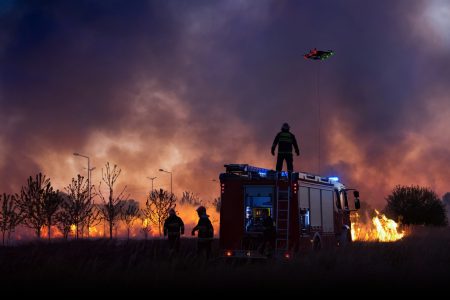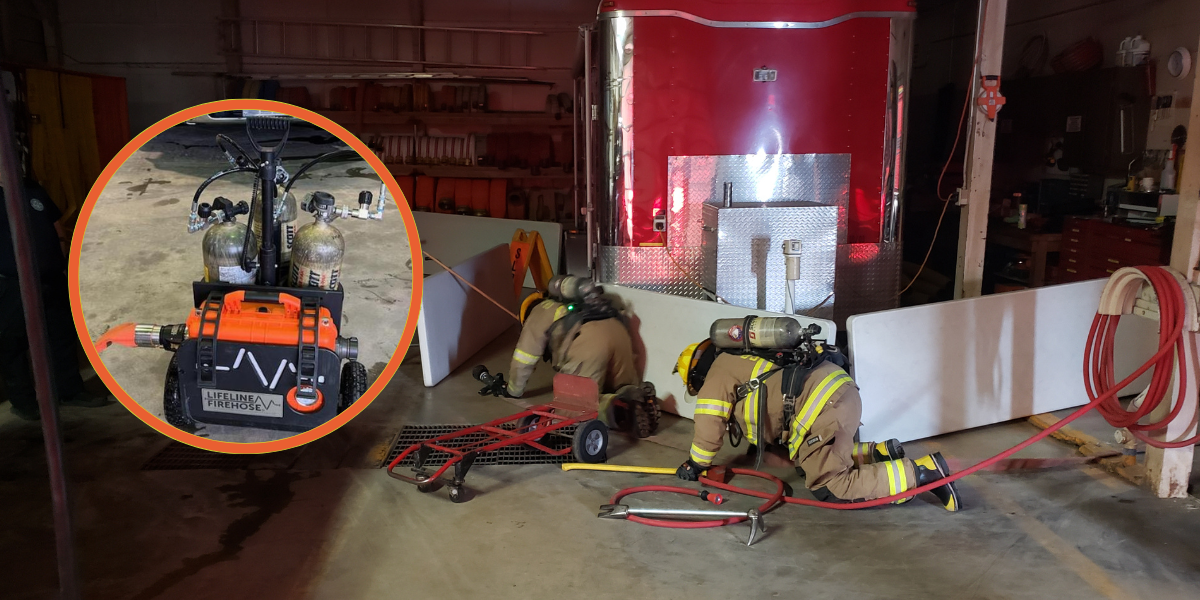Aerial firefighting plays a crucial role in putting out wildfires, whether it be releasing retardants or water from planes, or gaining an overview by drone
Each year the temperature rises, causing more heat and increased likelihood of wildfires. Not only is this devastating for wildlife and forest conservation, but also for inhabitants who lose loved ones, their homes or their businesses. It is the fire services responsibility for tackling these fires and minimising damage. So, what equipment and resources can firefighters use? In addition to suppression foams and your typical firefighting equipment, aerial firefighting retardants and equipment also play a crucial role.
When it comes to wildfires, we normally see the images on the news – flames burning through woodland, orange skies, torched surroundings and evacuated towns and cities. It is at this point where aerial firefighting is at its most important, as the actions taken at this point are what helps prevent spread of a wildfire and more importantly, helps save the lives of many. It is worth noting that aerial firefighting is there as a last resort – an acceptance that a fire has spiraled out of control to the point that drastic action is needed. Equally, the decisions made by those flying are critical.
“Over the course of just five days, more than two million gallons of fire retardant was dropped in California”
Firefighters work around the clock to eliminate wildfire spread. Aerial firefighting provides a core component to the putting out of wildfires around the globe. With the California wildfires for example over the course of just five days, more than two million gallons of fire retardant was dropped in California in an effort to control blazes. So, what exactly is that bright red slurry dropped by planes during wildfires?
The most common type of aircraft that we see being deployed in reaction to a wildfire are the fixed wing vehicles, which are perhaps the ones we’re more accustomed to seeing on the news. What we tend to see is a plane dropping fire retardant and/or water over swathes of land, in a calculated attempt to extinguish the flames, or at the very least, halt them in their tracks and to control the spread.
Several different types of fire retardant may be used in fighting wildfires, including:
- Long-Term Retardants: These water-based mixtures often contain ammonium phosphate salts and other additives, and they are typically dropped on wood fuel in advance of a fire. The salts promote charring of wood materials, so the mixture continues to provide fire retardancy after the water has evaporated. The distinctive bright red coloring is an added dye that makes it easier for responders to keep track of treated areas.
- Class A Foams and Water Enhancers: These water-based mixtures are applied directly to flames and are often used for the protection of structures. They contain solvents and surfactants that help the water “stick to” and soak into materials so that it can work more effectively. Foams may be aerially dropped; but these products are also used in ground operations.
These flame retardant mixtures are different from the flame retardant chemicals historically used in furniture. Flame retardants used in furniture have been associated with chronic adverse human health impacts, such as learning deficits, reduced fertility and cancer. In contrast, fire retardants used in wildland firefighting may cause some skin irritation on direct contact, but they are not considered a chronic health risk.
“Protection of people, structures and property are priorities for fire management, and an especially difficult challenge“
Flame retardant chemicals used in home furniture to comply with standards like the outdated Technical Bulletin 117 generally provide no meaningful improvement in fire safety. In contrast, aerial fire retardant, Class A foams, and water enhancers can facilitate protection of firefighters and the public beyond the use of plain water in the right conditions. While they are generally not considered harmful to humans, these wildland firefighting products can cause unintended harm to ecosystems if they are not used carefully. Components of these mixtures can be toxic to aquatic life (for example, if they are accidentally dropped into streams or bodies of water); for this reason, the US Forest Service has a policy of not dropping retardant within 300 or more feet of waterways. In addition, use of these fire retardant mixtures may contribute to reduced plant diversity in areas of regrowth after a fire.
Protection of people, structures and property are priorities for fire management, and an especially difficult challenge in the so-called “wildland urban interface”. Sometimes, fire retardant solutions may be invaluable for managing wildland fires; other times, they may not be as effective. Since fire seasons are expected to worsen, it is increasingly important for experts and regulators to employ strategies beyond fire suppression, such as strategic forest restoration and reduced development in fire-prone landscapes.
Other uses
The past few years have seen an increase in demand for aerial assets globally. Agencies around the world are looking for more resources to deploy water from the sky as fire seasons are ravaging once pristine landscapes. But how do resources and tactics change in different continents?
Brittany Wise of Erickson states, “From an operator’s perspective, aerial firefighting is standard practice depending on the platform and chosen application method. Operators must adapt their strategy based on localised regulatory and safety requirements (i.e. duty time, flight hour limits); however, agencies worldwide differ in their needs, preferences, and use of aerial assets. Individual agencies have different approaches to executing initial and extended aerial attacks on fires based on local regulations, challenges, and tactical, operational strategies. These individualised approaches vary by country and are specific to each region to ensure maximum effectiveness of the aerial resources sourced. Countries and their supporting fire agencies have a difficult task balancing risk and costs while protecting their constituents’ lives and property.”
Aerial firefighting resources come in many shapes, sizes and capabilities. Canada-based Conair, for example, has a fleet of over 70 fixed-wing aircraft, each one fitting into a specific part of a wildfire control agency’s fire management plan. “The majority of our aircraft are secured via long-term exclusive-use contracts for a specific number of days each year corresponding to the anticipated need of the particular agency. The first step in developing an aerial firefighting service is understanding the needs of the agency and the conditions in the area of concern,” said Jeff Berry, Director of Business Development at Conair. “Factors to consider include the size of the airport ramp and the length of the runway, location and services available, water sources in proximity to the area of concern and their size, what time of year the fires occur, the land status and burn permitting system, detection ground firefighting resources, the use of suppressants or retardants, and the cost-benefit of fighting the fires.”
As we know, managing vegetation and controlled uses of fire – under highly monitored conditions –is the first step of trying to prevent a wildfire, but this isn’t always enough. In this instance, when the smoke is spotted aircraft can be flown out there and then, but in Europe this is generally not the case. What tends to happen is – especially in remote locations – a plane or a helicopter will scout the fire and analyse the fire before reporting back, with teams on the ground looking to try and combat it as best they can. Should this prove futile though, then at that stage we start to see the aircraft in the sky dropping gallons of water or fire retardant to try and stem the tide and eventually, gain a foothold in controlling the flames.
What we see at this point is helicopters or water bombers flying through the sky and dropping gallons of water on the fire to try and put it out, with many doing repeated runs over it to try and limit growth. This can be an issue if the smoke becomes too dark, as the decrease in visibility means that aircraft are unable to safely try and extinguish the flames. Water aidThe way that the helicopters and fixed wing aircrafts themselves that are equipped with water is a stroke of genius.
“Fire aviation goes beyond just helicopters and planes, you can find smokejumpers”
Helicopters will be hooked up with either a tank full of water (thus becoming a helitanker) or carry buckets, which can be filled by submerging, portable tanks, reservoirs, rivers or lakes. Once emptied, these buckets are then promptly refilled on landing, before the choppers go back up into the air to go for another run. Sikorsky, Mil and Bell have produced some hugely effective and efficient helitankers over the years, with their work saving millions. In addition to water, helicopters are also used to deliver resources to the fireline, as well as transport crews. To say they are a vital part of tackling wildfires from the skies would be an understatement.
Smokejumpers and drones
However, fire aviation goes beyond just helicopters and planes, you can find smokejumpers, which are firefighters who parachute around the fringes of the fires to start the initial fightback, while also relaying guidance and offering their thoughts on what should come next.
In addition to those, you can also find drones being used prominently by fire departments to prevent wildfires, though they work in a totally different way than actively fighting the flames. When it comes to drones – and this is something that is being incorporated more and more on a global scale – they can be used to drop balls that spark a small and controllable fire in areas of vegetation that need removing, thus preventing further wildfires, but they are also actively used to detect and then manage wildfires. Having visuals on screen is a huge assistance and according to DroneFly.com, 69 out of the 347 public safety agencies that acquired drones between 2009 and 2017 were indeed fire departments. That number is only set to go up and in a report from Goldman Sachs, it’s now estimated that close to a billion dollars ($881m to be exact) could be spent on drone use when it comes to aerial firefighting across the planet.
Aviation and aerial firefighting, whether it is the use of planes and aircrafts, drones, transportation or visual overviews, plays a crucial role in eradicating wildfires. As the world watches as wildfire season takes hold of more and more countries every year, new technologies must be innovated to provide the best means for putting out fires.
Commentary: Edward Goldberg, CEO, Perimeter Solutions
As the wildfire season grows in length and intensity, it is more important than ever that firefighters and fire management agencies are equipped with the tools they need to effectively manage these fires. And these tools, including long-term fire retardant, must be safe, effective, and reliable.

As early as the 1950’s various chemicals were investigated as active fire-retardant ingredients, including sodium silicate, magnesium chloride, ammonium sulfate, ammonium phosphate, and others. In a 1954 study called Operation Firestop, the USDA Forest Service (USFS) and other agencies tested these chemicals for their effectiveness as a fire retardant. Ammonium phosphate was among the most effective chemicals in reducing fire intensity, while boric acid, magnesium chloride, and polyvinyl acetate were among the worst. Phosphate-based retardants became the industry standard, while boric acid, magnesium chloride, and polyvinyl acetate were discarded and no longer considered viable options.
In 1970, University of Montana scientist Aylmer D. Blakely built on what was found in Operation Firestop and looked at additional chemicals and effectiveness parameters. Blakely concluded in his paper, A Laboratory Method for Evaluating Forest Fire Retardant Chemicals, that ammonium phosphates topped the list of effective retardant chemicals. Potassium chloride was the least effective (finishing 14 out of 14 chemicals tested) and magnesium chloride finished ninth.
As a 20-year veteran of the fire safety industry, it is disheartening to see that despite the research supporting the use of ammonium phosphate as the most effective active ingredient for fire retardants, and the continued advancements being made with phosphate-based retardant, that fringe players in the industry are introducing new long-term retardants that promote the use of chemicals already determined to be detrimental and ineffective. Phosphate-based long-term retardants have served as a proven effective solution for more than 60 years, and that is why they continue to be the retardant of choice by the USFS and other agencies to fight wildfires.
Chris McCall, CEO, Fotokite
Save team resources and gain the elevated situational awareness that your team needs to stay safe, save lives and preserve property. With the single push of a button, fire response teams can now quickly visualise hot spots before putting personnel in danger.

Drones have the capabilities of offering more to first responders in addition to tackling real time fires. Fotokite tethered UAV is equipped with both low-light regular and FLIR thermal imaging cameras that enable public safety teams with the ability to gain the essential thermal information of an object or place post fire. The capability to detect remaining hot spots from the height of up to 45m/150ft provides these teams with the tools and situational awareness necessary to act quickly and efficiently with team safety and resources in mind. This is particularly useful for fires within difficult environments, or when tackling large scale fires such as wildfires.
With non-stop flight time and secure video streaming to the ground, it is now possible to track and detect valuable intelligence in low-visibility scenarios. The use of the elevated thermal camera allows you to clearly observe your scene, track your team, and direct operations. Dual video streaming quality enables the ability to clearly visualise hose lines and see if water jets are hitting where they need to. Forest fire and mutual aid responses can be more efficiently understood, communicated and coordinated in real-time given an elevated, contextual overview of your scene and the resources on site.
Fotokite tethered UAV is an accessible tool for nearly any post-fire inspection operation, in both urban and rural areas, due to the safety, redundancy, self-piloting and regulatory advantages of the Fotokite Sigma over traditional drones. Night-time operations or inclement weather conditions are no problem for drones. Their ruggedised design and thermal imaging capabilities enable the Kite to cut through challenging conditions and help understand the scene until the mission is complete.
To stay up to date on the latest, trends, innovations, people news and company updates within the global fire market please register to receive our newsletter here.
Media contact
Rebecca Morpeth Spayne,
Editor, International Fire Buyer
Tel: +44 (0) 1622 823 922
Email: editor@firebuyer.com









